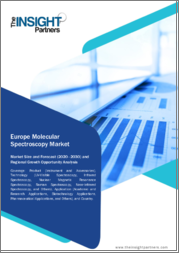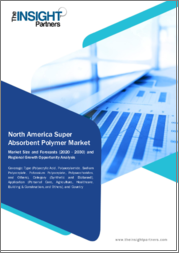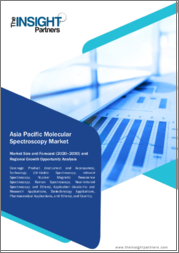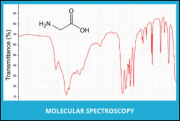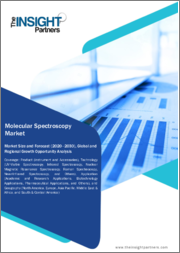
|
시장보고서
상품코드
1519443
세계의 분자 분광법 시장 보고서 : 제품 유형별, 기술별, 용도별, 지역별(2024-2032년)Molecular Spectroscopy Market Report by Product Type, Technology, Application, and Region 2024-2032 |
||||||
세계 분자 분광법 시장 규모는 2023년 68억 달러에 달했습니다. 향후 IMARC Group은 시장이 2032년까지 87억 달러에 이르며 2024-2032년 사이에 2.7%의 성장률(CAGR)을 나타낼 것으로 예측했습니다.
분자 분광법은 다양한 주파수와 에너지를 가진 전자기 방사선의 분산과 상호작용을 통해 분자의 정량적·정성적 특성을 연구하는 양자물리학의 수법입니다. 이 기술은 조성과 구조 정보를 추측하기 위해 흡수 패턴 또는 스펙트럼을 생성하는 데 도움이 됩니다. 이러한 특성으로부터 분자분광법은 환경시험, 학술연구, 생명공학, 식음료(F&B) 평가 등에 널리 이용되고 있습니다. 현재 핵 자기 공명(NMR), 라만, 자외선(UV) - 가시, 질량, 적외선, 근적외선 분광 등 다양한 유형의 기술을 사용할 수 있습니다.
분자 분광법 시장 경향:
식음료(F&B), 바이오테크놀러지, 특히 의료 부문 등 다양한 산업 부문에서 CT(컴퓨터 단층 촬영) 장치나 PET(양전자 방사 단층 촬영) 장치 등의 효율적이고 정확한 하이브리드 이미징 시스템 도입 하기 위해 분자 분광법이 널리 채용되고 있는 것이 주로 시장의 성장을 견인하고 있습니다. 또한 분자 분광법의 급속한 기술 발전과 새로운 분자를 발견하기 위해 제약 업계에서 널리 채택되어 시장 성장을 지원합니다. 분석 기술에 비해 샘플 준비가 쉽고 한 스펙트럼에서 더 나은 결과를 얻을 수 있습니다. 이에 따라 소비자들 사이에서 환경에 대한 의식이 높아지고 있는 것, 환경 스크리닝, 폐수 처리, 천연 자원의 고갈을 억제하기 위한 다환 방향족 탄화수소(PAH) 수준의 평가 등 분자 분광 법의 채택을 촉진하기 위해 여러 국가의 정부가 실시하는 수많은 유리한 이니셔티브도 다른 성장 촉진요인으로 작용하고 있습니다. 게다가 품질관리의 실시, 함유물의 순도 평가, 유기화합물의 분자구조 결정을 위한 핵자기공명(NMR) 분광기술의 사용량 증가가 시장 성장에 기여하고 있습니다. 그 밖에 식품안전에 대한 관심 증가, 생명공학산업의 현저한 확대, 코로나바이러스병(COVID-19)시험에 대한 라만분광법의 응용 증가 등이 세계 시장 성장을 적극적으로 자극하고 있습니다.
이 보고서에서 다루는 주요 질문
- 2023년 세계 분자분광법 시장 규모는?
- 2024-2032년 세계의 분자 분광법 시장의 예상 성장률은?
- 세계 분자 분광법 시장을 견인하는 주요 요인은?
- 세계 분자 분광법 시장에 대한 COVID-19의 영향은?
- 세계 분자 분광법 시장의 제품 유형별 내역은?
- 세계 분자 분광법 시장의 용도별 내역은?
- 세계 분자 분광법 시장의 주요 지역은?
- 세계 분자 분광법 시장의 주요 진출기업은?
목차
제1장 서문
제2장 조사 범위와 조사 방법
- 조사의 목적
- 이해관계자
- 데이터 소스
- 1차 정보
- 2차 정보
- 시장 추정
- 상향식 접근
- 하향식 접근
- 조사 방법
제3장 주요 요약
제4장 소개
- 개요
- 주요 업계 동향
제5장 세계의 분자 분광법 시장
- 시장 개요
- 시장 실적
- COVID-19의 영향
- 시장 예측
제6장 시장 내역: 제품 유형별
- 소모품
- 기기
제7장 시장 분석 : 기술별
- NMR 분광법
- 라만 분광법
- 자외선 가시광선 분광법
- 질량 분석
- 적외선 분광법
- 근적외 분광법
- 기타
제8장 시장 분석 : 용도별
- 의약품 용도
- 식음료 시험
- 바이오테크놀러지 및 바이오의약품 용도
- 환경시험
- 학술연구
- 기타
제9장 시장 분석 : 지역별
- 북미
- 미국
- 캐나다
- 아시아태평양
- 중국
- 일본
- 인도
- 한국
- 호주
- 인도네시아
- 기타
- 유럽
- 독일
- 프랑스
- 영국
- 이탈리아
- 스페인
- 러시아
- 기타
- 라틴아메리카
- 브라질
- 멕시코
- 기타
- 중동 및 아프리카
- 시장 동향
- 시장 분석 : 국가별
- 시장 예측
제10장 SWOT 분석
- 개요
- 강점
- 약점
- 기회
- 위협
제11장 밸류체인 분석
제12장 Porter's Five Forces 분석
- 개요
- 구매자의 협상력
- 공급기업의 협상력
- 경쟁도
- 신규 진입업자의 위협
- 대체품의 위협
제13장 가격 분석
제14장 경쟁 구도
- 시장 구조
- 주요 기업
- 주요 기업 프로파일
- ABB Ltd.
- Agilent Technologies Inc.
- Bruker Corporation
- Hitachi Ltd.
- Horiba Ltd.
- JASCO Inc.
- JEOL Ltd.
- Medtronic plc
- Merck KGaA
- PerkinElmer Inc.
- Shimadzu Corporation
- Thermo Fisher Scientific Inc.
- VIAVI Solutions Inc.
The global molecular spectroscopy market size reached US$ 6.8 Billion in 2023. Looking forward, IMARC Group expects the market to reach US$ 8.7 Billion by 2032, exhibiting a growth rate (CAGR) of 2.7% during 2024-2032.
Molecular spectroscopy is identified as the subject of quantum physics that studies quantitative and qualitative characteristics of molecules through dispersion and interaction of electromagnetic radiations with various frequencies and energies. This procedure aids in producing an absorption pattern, or spectrum, in order to deduce compositional or structural information. On account of these properties, molecular spectroscopy is extensively employed in environmental testing, academic research, biotechnology, and food and beverage (F&B) assessments. At present, it is available in varying technology types, including nuclear magnetic resonance (NMR), Raman, ultraviolet (UV)-visible, mass, infrared and near-infrared spectroscopy.
Molecular Spectroscopy Market Trends:
The widespread adoption of molecular spectroscopy across various industrial verticals, such as food and beverage (F&B), biotechnology, and particularly the healthcare sector, for introducing several efficient and accurate hybrid imaging systems, such as computed tomography (CT) and positron emitted tomography (PET) devices, is primarily driving the market toward growth. Moreover, rapid technological advancements in molecular spectroscopy and their widespread adoption in the pharmaceutical industry to discover newer molecules are also supporting the market growth. As compared to analytical techniques, they offer easier sample preparation and better outcomes from one single spectrum. In line with this, the rising environmental consciousness amongst consumers, along with numerous favorable initiatives undertaken by the government of several countries to promote the employment of molecular spectroscopy for environmental screening, treating wastewater and evaluating polycyclic aromatic hydrocarbons (PAH) levels to inhibit the depletion of natural resources are acting as other growth-inducing factors. Additionally, the rising usage of nuclear magnetic resonance (NMR) spectroscopy technology for implementing quality control, assessing the content purity, and determining the molecular structure of organic compounds is contributing to the market growth. Other factors, such as rising food safety concerns, significant expansion of the biotechnology industry, and the increasing application of Raman spectroscopy for coronavirus disease (COVID-19) testing are positively stimulating the market growth across the globe.
Key Market Segmentation:
IMARC Group provides an analysis of the key trends in each sub-segment of the global molecular spectroscopy market report, along with forecasts at the global, regional and country level from 2024-2032. Our report has categorized the market based on product type, technology and application.
Breakup by Product Type:
Consumables
Instruments
Breakup by Technology:
NMR Spectroscopy
Raman Spectroscopy
UV-Visible Spectroscopy
Mass Spectroscopy
Infrared Spectroscopy
Near-Infrared Spectroscopy
Others
Breakup by Application:
Pharmaceutical Applications
Food and Beverage Testing
Biotechnology and Biopharmaceutical Applications
Environmental Testing
Academic Research
Others
Breakup by Region:
North America
United States
Canada
Asia-Pacific
China
Japan
India
South Korea
Australia
Indonesia
Others
Europe
Germany
France
United Kingdom
Italy
Spain
Russia
Others
Latin America
Brazil
Mexico
Others
Middle East and Africa
Competitive Landscape:
The competitive landscape of the industry has also been examined along with the profiles of the key players being ABB Ltd., Agilent Technologies Inc., Bruker Corporation, Hitachi Ltd., Horiba Ltd., JASCO Inc., JEOL Ltd., Medtronic plc, Merck KGaA, PerkinElmer Inc., Shimadzu Corporation, Thermo Fisher Scientific Inc. and VIAVI Solutions Inc.
Key Questions Answered in This Report
- 1. What was the size of the global molecular spectroscopy market in 2023?
- 2. What is the expected growth rate of the global molecular spectroscopy market during 2024-2032?
- 3. What are the key factors driving the global molecular spectroscopy market?
- 4. What has been the impact of COVID-19 on the global molecular spectroscopy market?
- 5. What is the breakup of the global molecular spectroscopy market based on the product type?
- 6. What is the breakup of the global molecular spectroscopy market based on the technology?
- 7. What is the breakup of the global molecular spectroscopy market based on the application?
- 8. What are the key regions in the global molecular spectroscopy market?
- 9. Who are the key players/companies in the global molecular spectroscopy market?
Table of Contents
1 Preface
2 Scope and Methodology
- 2.1 Objectives of the Study
- 2.2 Stakeholders
- 2.3 Data Sources
- 2.3.1 Primary Sources
- 2.3.2 Secondary Sources
- 2.4 Market Estimation
- 2.4.1 Bottom-Up Approach
- 2.4.2 Top-Down Approach
- 2.5 Forecasting Methodology
3 Executive Summary
4 Introduction
- 4.1 Overview
- 4.2 Key Industry Trends
5 Global Molecular Spectroscopy Market
- 5.1 Market Overview
- 5.2 Market Performance
- 5.3 Impact of COVID-19
- 5.4 Market Forecast
6 Market Breakup by Product Type
- 6.1 Consumables
- 6.1.1 Market Trends
- 6.1.2 Market Forecast
- 6.2 Instruments
- 6.2.1 Market Trends
- 6.2.2 Market Forecast
7 Market Breakup by Technology
- 7.1 NMR Spectroscopy
- 7.1.1 Market Trends
- 7.1.2 Market Forecast
- 7.2 Raman Spectroscopy
- 7.2.1 Market Trends
- 7.2.2 Market Forecast
- 7.3 UV-Visible Spectroscopy
- 7.3.1 Market Trends
- 7.3.2 Market Forecast
- 7.4 Mass Spectroscopy
- 7.4.1 Market Trends
- 7.4.2 Market Forecast
- 7.5 Infrared Spectroscopy
- 7.5.1 Market Trends
- 7.5.2 Market Forecast
- 7.6 Near-Infrared Spectroscopy
- 7.6.1 Market Trends
- 7.6.2 Market Forecast
- 7.7 Others
- 7.7.1 Market Trends
- 7.7.2 Market Forecast
8 Market Breakup by Application
- 8.1 Pharmaceutical Applications
- 8.1.1 Market Trends
- 8.1.2 Market Forecast
- 8.2 Food and Beverage Testing
- 8.2.1 Market Trends
- 8.2.2 Market Forecast
- 8.3 Biotechnology and Biopharmaceutical Applications
- 8.3.1 Market Trends
- 8.3.2 Market Forecast
- 8.4 Environmental Testing
- 8.4.1 Market Trends
- 8.4.2 Market Forecast
- 8.5 Academic Research
- 8.5.1 Market Trends
- 8.5.2 Market Forecast
- 8.6 Others
- 8.6.1 Market Trends
- 8.6.2 Market Forecast
9 Market Breakup by Region
- 9.1 North America
- 9.1.1 United States
- 9.1.1.1 Market Trends
- 9.1.1.2 Market Forecast
- 9.1.2 Canada
- 9.1.2.1 Market Trends
- 9.1.2.2 Market Forecast
- 9.1.1 United States
- 9.2 Asia-Pacific
- 9.2.1 China
- 9.2.1.1 Market Trends
- 9.2.1.2 Market Forecast
- 9.2.2 Japan
- 9.2.2.1 Market Trends
- 9.2.2.2 Market Forecast
- 9.2.3 India
- 9.2.3.1 Market Trends
- 9.2.3.2 Market Forecast
- 9.2.4 South Korea
- 9.2.4.1 Market Trends
- 9.2.4.2 Market Forecast
- 9.2.5 Australia
- 9.2.5.1 Market Trends
- 9.2.5.2 Market Forecast
- 9.2.6 Indonesia
- 9.2.6.1 Market Trends
- 9.2.6.2 Market Forecast
- 9.2.7 Others
- 9.2.7.1 Market Trends
- 9.2.7.2 Market Forecast
- 9.2.1 China
- 9.3 Europe
- 9.3.1 Germany
- 9.3.1.1 Market Trends
- 9.3.1.2 Market Forecast
- 9.3.2 France
- 9.3.2.1 Market Trends
- 9.3.2.2 Market Forecast
- 9.3.3 United Kingdom
- 9.3.3.1 Market Trends
- 9.3.3.2 Market Forecast
- 9.3.4 Italy
- 9.3.4.1 Market Trends
- 9.3.4.2 Market Forecast
- 9.3.5 Spain
- 9.3.5.1 Market Trends
- 9.3.5.2 Market Forecast
- 9.3.6 Russia
- 9.3.6.1 Market Trends
- 9.3.6.2 Market Forecast
- 9.3.7 Others
- 9.3.7.1 Market Trends
- 9.3.7.2 Market Forecast
- 9.3.1 Germany
- 9.4 Latin America
- 9.4.1 Brazil
- 9.4.1.1 Market Trends
- 9.4.1.2 Market Forecast
- 9.4.2 Mexico
- 9.4.2.1 Market Trends
- 9.4.2.2 Market Forecast
- 9.4.3 Others
- 9.4.3.1 Market Trends
- 9.4.3.2 Market Forecast
- 9.4.1 Brazil
- 9.5 Middle East and Africa
- 9.5.1 Market Trends
- 9.5.2 Market Breakup by Country
- 9.5.3 Market Forecast
10 SWOT Analysis
- 10.1 Overview
- 10.2 Strengths
- 10.3 Weaknesses
- 10.4 Opportunities
- 10.5 Threats
11 Value Chain Analysis
12 Porters Five Forces Analysis
- 12.1 Overview
- 12.2 Bargaining Power of Buyers
- 12.3 Bargaining Power of Suppliers
- 12.4 Degree of Competition
- 12.5 Threat of New Entrants
- 12.6 Threat of Substitutes
13 Price Analysis
14 Competitive Landscape
- 14.1 Market Structure
- 14.2 Key Players
- 14.3 Profiles of Key Players
- 14.3.1 ABB Ltd.
- 14.3.1.1 Company Overview
- 14.3.1.2 Product Portfolio
- 14.3.1.3 Financials
- 14.3.1.4 SWOT Analysis
- 14.3.2 Agilent Technologies Inc.
- 14.3.2.1 Company Overview
- 14.3.2.2 Product Portfolio
- 14.3.2.3 Financials
- 14.3.2.4 SWOT Analysis
- 14.3.3 Bruker Corporation
- 14.3.3.1 Company Overview
- 14.3.3.2 Product Portfolio
- 14.3.3.3 Financials
- 14.3.3.4 SWOT Analysis
- 14.3.4 Hitachi Ltd.
- 14.3.4.1 Company Overview
- 14.3.4.2 Product Portfolio
- 14.3.4.3 Financials
- 14.3.4.4 SWOT Analysis
- 14.3.5 Horiba Ltd.
- 14.3.5.1 Company Overview
- 14.3.5.2 Product Portfolio
- 14.3.5.3 Financials
- 14.3.6 JASCO Inc.
- 14.3.6.1 Company Overview
- 14.3.6.2 Product Portfolio
- 14.3.7 JEOL Ltd.
- 14.3.7.1 Company Overview
- 14.3.7.2 Product Portfolio
- 14.3.7.3 Financials
- 14.3.7.4 SWOT Analysis
- 14.3.8 Medtronic plc
- 14.3.8.1 Company Overview
- 14.3.8.2 Product Portfolio
- 14.3.8.3 Financials
- 14.3.8.4 SWOT Analysis
- 14.3.9 Merck KGaA
- 14.3.9.1 Company Overview
- 14.3.9.2 Product Portfolio
- 14.3.9.3 Financials
- 14.3.9.4 SWOT Analysis
- 14.3.10 PerkinElmer Inc.
- 14.3.10.1 Company Overview
- 14.3.10.2 Product Portfolio
- 14.3.10.3 Financials
- 14.3.10.4 SWOT Analysis
- 14.3.11 Shimadzu Corporation
- 14.3.11.1 Company Overview
- 14.3.11.2 Product Portfolio
- 14.3.11.3 Financials
- 14.3.11.4 SWOT Analysis
- 14.3.12 Thermo Fisher Scientific Inc.
- 14.3.12.1 Company Overview
- 14.3.12.2 Product Portfolio
- 14.3.12.3 Financials
- 14.3.12.4 SWOT Analysis
- 14.3.13 VIAVI Solutions Inc.
- 14.3.13.1 Company Overview
- 14.3.13.2 Product Portfolio
- 14.3.13.3 Financials
- 14.3.1 ABB Ltd.









